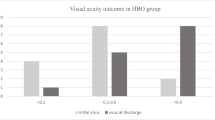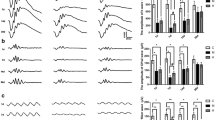Abstract
Purpose
Central retinal artery occlusion (CRAO) is one of the serious ophthalmological emergencies with poor visual prognosis. Iloprost is a stable prostacyclin analogue and has prominent anti-edema, anti-inflammatory, vasodilatory, and antiagregant effects. The main objective of this work was to investigate iloprost as an alternative agent versus hyperbaric oxygen (HBO) in the treatment of CRAO.
Methods
Twenty-eight healthy Wistar albino male rats were randomly assigned into control (n = 7, sham operation), HBO (n = 7), iloprost (n = 7), and sham groups (n = 7). CRAO model was created through optic nerve exploration and ligation. Full-thickness retina (FTR), outer nuclear layer (ONL), inner nuclear layer (INL) and ganglion cell layer (GCL) thickness were measured on Hematoxylin/Eosin (H&E) stained retinal sections and immunohistochemical analysis including terminal deoxynucleotidyl transferase-mediated biotindeoxyuridine triphosphate nick-end labeling (TUNEL) assay was performed to determine the apoptotic index (AI).
Results
AI values of HBO (0.204 ± 0.067) and iloprost (0.197 ± 0.052) groups were significantly lower than sham (0.487 ± 0.046) group (p < 0.001). Any significant difference was found between the HBO and iloprost groups in terms of AI (p = 0.514). A statistically significant increase in thickness of FTR, ONL, INL and GCL was detected in HBO, iloprost and sham groups compared to the control group (p = 0.002). FTR, ONL, INL and GCL thickness were significantly thinner in HBO and iloprost groups than in the sham group (p = 0.002). A significant lesser increase was observed in all the retinal layers thickness in iloprost group versus HBO group (p = 0.002) except for INL (p = 0.665).
Conclusions
The study results demonstrated anti-edema, neuroprotective, and anti-apoptotic effects of iloprost quantitatively; thus, iloprost may be a beneficial alternative agent in the treatment of CRAO.






Similar content being viewed by others
References
Jiménez-Gallo D, Albarrán-Planelles C, Arjona-Aguilera C, Blanco-Sánchez G, Rodríguez-Mateos ME, Linares-Barrios M (2015) Treatment of thromboangiitis obliterans (Buerger’s disease) with high-potency vasodilators. Dermatol Ther 28(3):135–139
Çevirme D, Aksoy E, Gül YG et al (2015) Intravenous iloprost for treatment of critical limb ischemia in patients unsuitable for revascularization. Vascular 23(5):483–489
Cha KS, Cho KI, Seo JS et al (2013) Effects of inhaled iloprost on exercise capacity, quality of life, and cardiac function in patients with pulmonary arterial hypertension secondary to congenital heart disease (the Eisenmenger syndrome) (from the EIGER Study). Am J Cardiol 112(11):1834–1839
Elinav E, Chajek-Shaul T, Stern M (2002) Improvement in cholesterol emboli syndrome after iloprost therapy. BMJ 324(7332):268–269
O’Connell C, Amar D, Boucly A et al (2016) Comparative safety and tolerability of Prostacyclins in pulmonary hypertension. Drug Saf 39(4):287–294
Stefansson E, Wilson CA, Schoen T, Kuwabara T (1988) Experimental ischemia induces cell mitosis in the adult rat retina. Invest Ophthalmol Vis Sci 29:1050–1055
Hangai M, Yoshimura N, Yoshida M, Yabuuchi K, Honda Y (1995) Interleukin- 1 gene expression in transient retinal ischemia in the rat. Invest Ophthalmol Vis Sci 36:571–578
Tsujikawa A, Ogura Y, Hiroshiba N, Miyamoto K, Kiryu J, Honda Y (1998) In vivo evaluation of leukocyte dynamics in retinal ischemia– reperfusion injury. Invest Ophthalmol Vis Sci 39:793–800
Gundersen HJ, Bendtsen TF, Korbo L et al (1988) Some new, simple and efficient stereological methods and their use in pathological research and diagnosis. APMIS 96(5):379–394
Patz A (1955) Oxygen inhalation in retinal arterial occlusion. Am J Ophthalmol 40(6):789–795
Nishijima K, Kiryu J, Tsujikawa A et al (2001) In vivo evaluation of platelet-endothelial interactions after transient retinal ischemia. Invest Ophthalmol Vis Sci 42(9):2102–2109
Varma DD, Cugati S, Lee AW, Chen CS (2013) A review of central retinal artery occlusion: clinical presentation and management. Eye (Lond) 27(6):688–697
Gaydar V, Ezrachi D, Dratviman-storobinsky O, Hofstetter S, Avraham-Lubin BC, Goldberg-Cohen N (2011) Reduction of Apoptosis in ischemic retinas of two mouse models using hyperbaric oxygen treatment. Invest Ophthalmol Vis Sci 52(10):7514–7522
Kisch-Wedel H, Kemming G, Meisner F et al (2005) Effect of prostaglandin I2 analogues on left ventricular diastolic function in vivo. Eur J Pharmacol 517(3):208–216
Belch JJ (1987) Effect of iloprost (ZK 36374) on white cell behaviour. In: Gryglewski RJ, Stock G (eds) Prostacyclin and its stable analogue iloprost. Springer, Berlin, pp 97–102
Stürzebecher CS (1987) Effects of iloprost on platelet activation in vitro. In: Gryglewski RJ, Stock G (eds) Prostacyclin and its stable analogue iloprost. Springer, Berlin, pp 39–45
Lessiani G, Vazzana N, Cuccurullo C et al (2011) Inflammation, oxidative stress and platelet activation in aspirin-treated critical limb ischaemia: beneficial effects of iloprost. Thromb Haemost 105(2):321–328
Veroux P, Veroux M, Macarone M, Bonanno MG, Tumminelli MG (2004) Efficacy of a novel method of intravenous infusion of the prostaglandin analogue iloprost for the treatment of lower-limb critical ischemia: An open-label, nonrandomized study in two cohorts. Curr Ther Res Clin Exp 65(3):255–265
de Donato G, Gussoni G, de Donato G et al (2007) Ilaill Study Group, Acute limb ischemia in elderly patients: can iloprost be useful as an adjuvant to surgery? Results from the ILAILL study. Eur J Vasc Endovasc Surg 34(2):194–198
Mubarak KK (2010) A review of prostaglandin analogs in the management of patients with pulmonary arterial hypertension. Resp Med 104:9–21
Bozok S, Ilhan G, Yilmaz Y et al (2012) Protective effects of hyperbaric oxygen and iloprost on ischemia/reperfusion-induced lung injury in a rabbit model. Eur J Med Res 17:14
Caliskan A, Yavuz C, Karahan O et al (2014) Iloprost reduces myocardial edema in a rat model of myocardial ischemia reperfusion. Perfusion 29(3):260–264
Arslan M, Donmez T, Erer D, Tatar T, Comu FM, Alkan M (2013) Effect of iloprost on erythrocyte deformability in rat’s lower extremity undergoing an ischemia reperfusion injury. Bratisl Lek Listy 114(4):189–191
İlhan G, Aksun M, Ozpak B et al (2013) The Effect of combined hyperbaric oxygen and iloprost treatment on the prevention of spinal cord ischaemia-reperfusion injury : an experimental study. Eur J Cardiothorac Surg 44(5):e332–e340
Silistreli E, Kabakci B, Yilmaz E et al (2005) Early protective effects of iloprost, a stable prostacyclin analog, during spinal cord ischemia in a rabbit model. Heart Vessels 20(2):66–71
Kranke P, Bennett MH, Martyn-St James M et al (2015) Hyperbaric oxygen therapy for chronic wounds. Cochrane Database Syst Rev 24(6):CD004123
Author information
Authors and Affiliations
Corresponding author
Ethics declarations
Funding
No funding was received for this research. This work was supported by Kocaeli University Scientific Research Projects Unit (KOU-BAP: project No.2012/002).
Financial disclosure
The authors have no financial or proprietary interest in any product mentioned in the article.
Conflict of interest
All authors certify that they have no affiliations with or involvement in any organization or entity with any financial interest (such as honoraria; educational grants; participation in speakers’ bureaus; membership, employment, consultancies, stock ownership, or other equity interest; and expert testimony or patent-licensing arrangements), or non-financial interest (such as personal or professional relationships, affiliations, knowledge or beliefs) in the subject matter or materials discussed in this manuscript.
Animal experiments
Ethical approval: “All applicable international, national, and/or institutional guidelines for the care and use of animals were followed.”
Rights and permissions
About this article
Cite this article
Karaman, S., Ozkan, B., Yazir, Y. et al. Comparison of hyperbaric oxygen versus iloprost treatment in an experimental rat central retinal artery occlusion model. Graefes Arch Clin Exp Ophthalmol 254, 2209–2215 (2016). https://doi.org/10.1007/s00417-016-3444-5
Received:
Revised:
Accepted:
Published:
Issue Date:
DOI: https://doi.org/10.1007/s00417-016-3444-5




